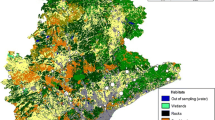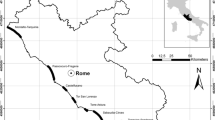Abstract
Human-driven landscape changes may promote plant invasions by increasing propagule pressure and providing favourable conditions for non-native species to establish and spread. The increase in invasion levels might not be immediate but rather exhibit a time-lag (i.e. invasion debt). Moreover, the relationship between invasion and landscape history (i.e. changes in landscape composition) might be extremely complex as it might also include extinction debts of invasive species currently in regression. In order to understand the effect of landscape history on plant invasion, we studied the invasion level in coastal plant communities affected by intense human-driven landscape alteration in the last 50 years. We identified all non-native plant species within 809 grid cells (250 × 250 m) along ~500 km of the Spanish SW coast. We tested the association of (1) non-native richness conditional on the overall presence of non-natives (at least one species), and (2) the occurrence of the most frequent non-native species, with the percentage of human land-cover categories in 1956, 1991 and 2007 using a multimodel inference approach. We used these models to project future invasion patterns in the region. We found non-native richness to be more associated with land-cover variables in 1956 than in 2007, suggesting the existence of an invasion debt, but not for the overall presence of non-natives. For most frequent species, the effects of past landscape alteration depended on the introduction pathway and the region of origin. Species used in agriculture were more related to past cropland area, while most of the species used in gardening or forestry showed higher affinity for recently altered areas. These results highlight the relevance of the species’ introduction history and landscape history in assessing future long-term invasion trends.



Similar content being viewed by others
References
Aikio S, Duncan RP, Hulme PE (2010) Lag-phases in alien plant invasions: separating the facts from the artefacts. Oikos 119:370–378
Aikio S, Duncan RP, Hulme PE (2012) The vulnerability of habitats to plant invasion: disentangling the roles of propagule pressure, time and sampling effort. Glob Ecol Biogeogr 21:778–871. doi:10.1111/j.1466-8238.2011.00711.x
Aragón P, Lobo JM (2012) Predicted effect of climate change on the invasibility and distribution of the Western corn root-worm. Agric For Entomol 14:13–18. doi:10.1111/j.1461-9563.2011.00532.x
Basnou C, Iguzquiza J, Pino J (2015) Examining the role of landscape structure and dynamics in alien plant invasion from urban Mediterranean coastal habitats. Landsc Urban Plan 136:156–164
Bennett JR, Vellend M, Lilley PL et al (2012) Abundance, rarity and invasion debt among exotic species in a patchy ecosystem. Biol Invasions 15:707–716. doi:10.1007/s10530-012-0320-z
Burnham KP, Anderson DR (2002) Model selection and multimodel inference: a practical information-theoretic approach, 2nd edn. Springer, New York
Catford JA, Vesk PA, White MD, Wintle BA (2011) Hotspots of plant invasion predicted by propagule pressure and ecosystem characteristics. Divers Distrib 17:1099–1110. doi:10.1111/j.1472-4642.2011.00794.x
Cavanilles AJ (1803) Descripción de las plantas que Don Antonio Josef Cavanilles demostró en las lecciones públicas del año 1802
Clavero M (2014) Shifting baselines and the conservation of non-native species. Conserv Biol 28:1434–1436. doi:10.1111/cobi.12266
Colmeiro M (1874) Plantas crasas de España y Portugal
Cousins SAO (2009) Extinction debt in fragmented grasslands: paid or not? J Veg Sci 20:3–7
Coutinho AX (1939) A Flora de Portugal, 2a edn. Lisboa
Cristofoli S, Piqueray J, Dufrêne M et al (2010) Colonization credit in restored wet heathlands. Restor Ecol 18:645–655. doi:10.1111/j.1526-100X.2008.00495.x
Crooks JA (2005) Lag times and exotic species: the ecology and management of biological invasions in slow-motion. Ecoscience 12:316–329. doi:10.2980/i1195-6860-12-3-316.1
DeGasperis BG, Motzkin G (2007) Windows of opportunity: historical and ecological controls on berberis thunbergii invasions. Ecology 88:3115–3125. doi:10.1890/06-2014.1
Doménech R, Vila M, Pino J, Gesti J (2005) Historical land-use legacy and Cortaderia selloana invasion in the Mediterranean region. Glob Change Biol 11:1054–1064. doi:10.1111/j.1365-2486.2005.00965.x
Dormann CF, McPherson JM, Araújo MB et al (2007) Methods to account for spatial autocorrelation in the analysis of species distributional data: a review. Ecography 30:609–628. doi:10.1111/j.2007.0906-7590.05171.x
Essl F, Dullinger S, Rabitsch W et al (2011) Socioeconomic legacy yields an invasion debt. Proc Natl Acad Sci 108:203–207. doi:10.1073/pnas.1011728108
Essl F, Mang T, Moser D (2012) Ancient and recent alien species in temperate forests: steady state and time lags. Biol Invasions 14:1331–1342. doi:10.1007/s10530-011-0156-y
Essl F, Dullinger S, Rabitsch W et al (2015) Historical legacies accumulate to shape future biodiversity in an era of rapid global change. Divers Distrib 21:534–547. doi:10.1111/ddi.12312
Ficetola GF, Maiorano L, Falcucci A et al (2010) Knowing the past to predict the future: land-use change and the distribution of invasive bullfrogs. Glob Change Biol 16:528–537. doi:10.1111/j.1365-2486.2009.01957.x
Gassó N, Sol D, Pino J et al (2009) Exploring species attributes and site characteristics to assess plant invasions in Spain. Divers Distrib 15:50–58
Gavier-Pizarro GI, Radeloff VC, Stewart SI et al (2010) Housing is positively associated with invasive exotic plant species richness in New England, USA. Ecol Appl 20:1913–1925. doi:10.1890/09-2168.1
Giraldo-Beltrán P, Andreu J, Pino J (2015) Exploring changes in the invasion pattern of alien flora in Catalonia (NE of Spain) from large datasets. Biol Invasions 17:3015–3028
González-Moreno P, Gassó N, Pino J, Vilà M (2013a) Landscape context modulates plant invasions in Mediterranean forest edges. Biol Invasions 15:547–557. doi:10.1007/s10530-012-0306-x
González-Moreno P, Pino J, Carreras D et al (2013b) Quantifying the landscape influence on plant invasions in Mediterranean coastal habitats. Landsc Ecol 28:891–903. doi:10.1007/s10980-013-9857-1
González-Moreno P, Diez JM, Ibáñez I et al (2014) Plant invasions are context-dependent: multiscale effects of climate, human activity and habitat. Divers Distrib 20:720–731. doi:10.1111/ddi.12206
Gracia FJ, Alonso C, Del Río L et al (2011) Las dunas del litoral gaditano. In: Sanjaume E, Gracia FJ (eds) Las dunas de España. Sociedad Española de Geomorfología, Madrid, España
Guillot D, Van der Meer P, Laguna E, Rosselló JA (2008) El género Agave L. en la flora alóctona valenciana. Monogr Rev Bouteloua 3:94
Hahs AK, McDonnell MJ, McCarthy MA, Vesk PA, Corlett RT, Norton BA, Clemants SE, Duncan RP, Thompson K, Schwartz MW, Williams NSG (2009) A global synthesis of plant extinction rates in urban areas. Ecol Lett 12:1165–1173
Hawkins BA (2012) Eight (and a half) deadly sins of spatial analysis. J Biogeogr 39:1–9. doi:10.1111/j.1365-2699.2011.02637.x
Jackson ST, Sax DF (2010) Balancing biodiversity in a changing environment: extinction debt, immigration credit and species turnover. Trends Ecol Evol 25:153–160. doi:10.1016/j.tree.2009.10.001
Keeley J, Baer-Keeley M, Fotheringham CJ (2005) Alien plant dynamics following fire in Mediterranean climate California shrublands. Ecol Appl 15:2109–2125
Kowarik I (1995) Time lags in biological invasions with regard to the success and failure of alien species. In: Pyšek P, Prach K, Rejmánek M, Wade M (eds) Plant invasions: general aspects and special problems. SPB Academic Publishing, Amsterdam, pp 15–38
Krauss J, Bommarco R, Guardiola M, Heikkinen RK, Helm A, Kuussaari M, Lindborg R, Öckinger E, Pärtel M, Pino J, Pöyry J (2010) Habitat fragmentation causes immediate and time-delayed biodiversity loss at different trophic levels. Ecol Lett 13(5):597–605
Kuussaari M, Bommarco R, Heikkinen RK, Helm A, Krauss J, Lindborg R, Öckinger E, Pärtel M, Pino J, Rodà F, Stefanescu C, Teder T, Zobel M, Steffan-Dewenter I (2009) Extinction debt: a challenge for biodiversity conservation. Trends Ecol Evol 24:564–571
Lira PK, Ewers RM, Banks-Leite C et al (2012) Evaluating the legacy of landscape history: extinction debt and species credit in bird and small mammal assemblages in the Brazilian Atlantic Forest. J Appl Ecol 49:1325–1333. doi:10.1111/j.1365-2664.2012.02214.x
Malavasi M, Carboni M, Cutini M et al (2014) Landscape fragmentation, land-use legacy and propagule pressure promote plant invasion on coastal dunes: a patch-based approach. Landsc Ecol 29:1541–1550. doi:10.1007/s10980-014-0074-3
Martínez F, Montero G, Ruiz-Peinado R et al (2004) Geobotánica e historia de los pinares de pino piñonero. Junta de Andalucía, Sevilla
Moreira JM, Gámez-Ramírez M, Caturla-Montero C et al (2010) Mapa de usos y coberturas vegetales del suelo de Andalucía. Junta de Andalucía, Sevilla
Ohlemüller R, Walker S, Bastow Wilson J (2006) Local vs regional factors as determinants of the invasibility of indigenous forest fragments by alien plant species. Oikos 112:493–501. doi:10.1111/j.0030-1299.2006.13887.x
O’rourke KH, Williamson JG (2004) Once more: when did globalisation begin? Eur Rev Econ Hist 8:109–117. doi:10.1017/S1361491604001078
Pärtel M, Szava-Kovats R, Zobel M (2011) Dark diversity: shedding light on absent species. Trends Ecol Evol 26:124–128
Peduzzi P, Concato J, Kemper E et al (1996) A simulation study of the number of events per variable in logistic regression analysis. J Clin Epidemiol 49:1373–1379. doi:10.1016/S0895-4356(96)00236-3
Pino J, Arnan X, Rodrigo A, Retana J (2013) Post-fire invasion and subsequent extinction of Conyza spp. in Mediterranean forests is mostly explained by local factors. Weed Res 53:470–478
Piqueray J, Cristofoli S, Bisteau E et al (2011) Testing coexistence of extinction debt and colonization credit in fragmented calcareous grasslands with complex historical dynamics. Landsc Ecol 26:823–836. doi:10.1007/s10980-011-9611-5
Polce C, Kunin WE, Biesmeijer JC, Dauber J, Phillips OL (2011) Alien and native plants show contrasting responses to climate and land use in Europe. Glob Ecol Biogeogr 20:367–379
Pyšek P, Prach K, Smilauer P (1995) Relating invasion success to plant traits: an analysis of the Czech alien flora. In: Pyšek P, Prach K, Rejmánek M, Wade M (eds) Plant invasions: general aspects and special problems. Academic Publishing, Amsterdam, pp 39–60
Pyšek P, Sádlo J, Mandák B, Jarošík V (2003) Czech alien flora and the historical pattern of its formation: what came first to Central Europe? Oecologia 135:122–130. doi:10.1007/s00442-002-1170-7
Quer J (1762) Flora Española. ó Historia de las plantas que se crian en España. Madrid, España
Ramón-Laca L (1999) Las plantas americanas en la obra de Charles de l’Ecluse: primeras citas
Sanz-Elorza M, Dana ED, Sobrino E (2004) Atlas de las plantas alóctonas invasoras en España. Dirección General para la Biodiversidad, Madrid
Sobrino E, Sanz-Elorza M, Dana ED, González-Moreno A (2009) Invasibility of a coastal strip in NE Spain by alien plants. J Veg Sci 13:585–594. doi:10.1111/j.1654-1103.2002.tb02085.x
Tilman D, May RM, Lehman CL, Nowak MA (1994) Habitat destruction and the extinction debt. Nature 371:65–66
Valdés B, Talavera S, Fernández-Galiano E (1987) Flora vascular de Andalucía occidental. Ketres, Barcelona
Vilà M, Ibáñez I (2011) Plant invasions in the landscape. Landsc Ecol 26:461–472
Vilà M, Burriel JA, Pino J et al (2003) Association between Opuntia species invasion and changes in land-cover in the Mediterranean region. Glob Change Biol 9:1234–1239. doi:10.1046/j.1365-2486.2003.00652.x
Vittinghoff E, McCulloch CE (2007) Relaxing the rule of ten events per variable in logistic and cox regression. Am J Epidemiol 165:710–718. doi:10.1093/aje/kwk052
Zuur AF, Ieno EN, Walker NJ, Saveliev AA, Smith GM (2009) Mixed effects models and extensions in ecology with R. Springer, New York
Acknowledgements
We thank J. P. González-Varo, E. Revilla, R. Early, N. Roura-Pascual, and two anonymous reviewers for their fruitful comments on the manuscript. We also thank E. Manzano and J.L. Espinar for their contribution during field work. This research was partially funded by the Severo Ochoa Program for Centres of Excellence in R+D+I (SEV-2012-0262), the Spanish Ministerio de Ciencia e Innovación projects Consolider-Ingenio MONTES (CSD2008-00040), RIXFUTUR (CGL2009-7515), and IMPLANTIN (CGL 2015-65346-R), and the Junta de Andalucía projects RNM-4031 and P06/RNM/02030.
Author information
Authors and Affiliations
Corresponding author
Electronic supplementary material
Below is the link to the electronic supplementary material.
Rights and permissions
About this article
Cite this article
González-Moreno, P., Pino, J., Cózar, A. et al. The effects of landscape history and time-lags on plant invasion in Mediterranean coastal habitats. Biol Invasions 19, 549–561 (2017). https://doi.org/10.1007/s10530-016-1314-z
Received:
Accepted:
Published:
Issue Date:
DOI: https://doi.org/10.1007/s10530-016-1314-z




